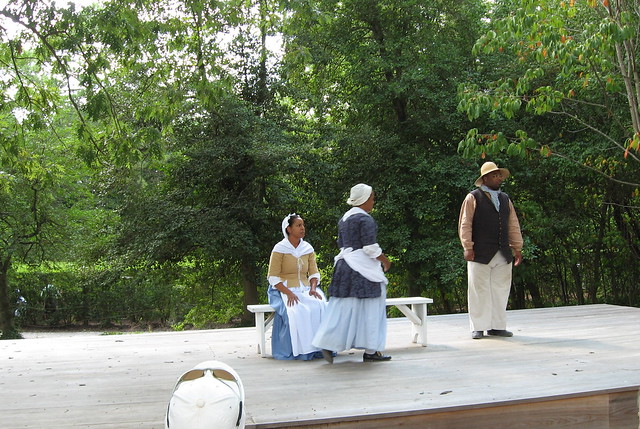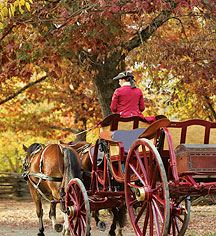
From the New York Times, "Mock Auction of Slaves: Education or Outrage?" by Michael Janofsky, on 8 October 1994 -- Here on Monday afternoon, four blacks -- two men and two women -- are scheduled to be auctioned to the highest bidder. They will stand outside a tavern while a dozen people look them over and call out how much they are willing to spend. The event is open to the public.
The "slaves" will be actors and the auction a drama, part of a three-day program called "Publick Times" designed to re-create life in Colonial Williamsburg. Organizers say the auction is intended only to educate visitors about a brutal yet important part of black American history. But critics around the state contend that education could be trivialized into entertainment and that, in any case, slave auctions were too painful to revive in any form.
"Our phones have been ringing off the hook," said Salim Khalfani of the Virginia branch of the National Association for the Advancement of Colored People. "The consensus is that people are outraged at what they're doing in Williamsburg."

Paradoxically, the re-enactment is part of an effort to balance the portrayal of history in Williamsburg, where 18th-century streets and buildings have been meticulously restored and history is kept alive by the Colonial Williamsburg Foundation.
The auction's organizer is the foundation's African-American interpretation and presentations department, which was formed 15 years ago to develop exhibits that reflect elements of black history that are not always included in school curriculums or municipal museums.
Previous projects have dealt with other aspects of Colonial slavery, including runaways, parenting and interracial relations. Five years ago, replicas of slave quarters -- rudimentary log cabins with slave families' meager belongings -- were built at Carter's Grove, an expansive James River plantation about five miles from Williamsburg. Enslaved Africans were taken to the estate at the end of the 17th century to work in the fields.


Until the foundation's African-American department was created, tourists who ambled along the streets of Williamsburg and strolled through its historic buildings were shown history only through a prism of the white experience. Little reflected black life, even though blacks made up as much as 50 percent of the region's population during Colonial times.
Christy S. Coleman, the department director, defended the simulated slave auction. "This is just the natural progression of what we've been doing," said Ms. Coleman, whose department includes 12 other blacks. "I recognize that this is a very, very sensitive and emotional issue. But it is also very real history, and it distresses me, personally and professionally, that there are those who would have us hide this or keep it under the rug."
In the 45-minute presentation, Ms. Coleman will play a slave offered at auction. The simulation will begin, she said, with a woman in contemporary clothes explaining what is about to take place. Then, as the bidding starts, Ms. Coleman and the three other "slaves" will be brought out in period dress. All those bidding will be white, she said, except for a black man representing a free black trying to buy his wife's freedom.

"That's the way it was back then," Ms. Coleman said. "A wife came with the land, not her husband."
Mr. Khalfani said that many callers to the N.A.A.C.P. office in Richmond say slave auctions represented such a wrenching chapter in black history that "they don't want to see it rehashed again." He also said many people expressed alarm that the re-creation might be inaccurate or sensationalized for entertainment.
A black man laying bricks in a driveway across from the office of the Colonial Williamsburg Foundation said he was disturbed to learn of the re-enactment. "Blacks around here don't want to be reminded," said the man, who refused to give his name because he said he feared "retribution" by Williamsburg officials. "It bothers people. People think it's very insensitive to dig it all up again."

But Ms. Coleman contended that only by open display and discussion could people understand the degradation and humiliation that blacks felt as chattel. She compared the pain of the slave auctions for blacks to that of the Holocaust for Jews and said that if museums were built to illustrate the horrors of one, why should not efforts be made to illustrate the other.
"The legacy of slavery in this country is racism," Ms. Coleman said. "Until we begin to understand the horrors that took place, the survival techniques enslaved Africans used, people will never come to understand what's happening in our society today." (source: The New York Times)

No comments:
Post a Comment